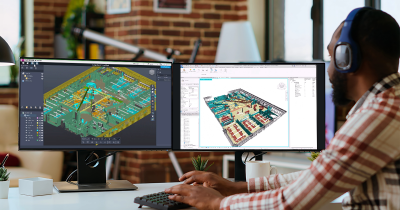Quanergy is at it again. The much-hyped LiDAR manufacturer has announced a miniature solid-state sensor, the S3-Qi, which they are showing off at XPONENTIAL this week in New Orleans.
What do they mean by miniature? The S3-Qi measures in at 15% the size of their previous solid-state model, the S3. It has a footprint of 1” by 1.5”, boasts “low” power consumption, and weighs in at only 100 g.
Solid-state LiDAR technology integrates the mechanical parts necessary for a LiDAR sensor to work into a single microchip. One of the great promises of the technology is its small size—many have speculated that it will be the advancement that puts LiDAR into personal devices like smartphones and tablets. To our knowledge, Quanergy’s S3-Qi would be the smallest commercially available solid-state LiDAR sensor to date.
Looking at the S3-Qi’s specs (and Quanergy’s decision to debut the sensor at XPONENTIAL), it’s clear that the sensor is being marketed primarily to the drone market. If the S3-Qi is successfully manufactured to Quanergy’s specifications, the small size and low weight mean it can fit within the payload of drones that usually cannot carry LiDAR sensors. The S3-Qi’s lower weight also promises longer battery runtime for larger, more powerful drones.
Quanergy has not released a final price for the sensor, but they are calling it “cost-effective” and slating mass production for Q1 of 2017. There is no indication whether the sensor will come in below or above the projected $250 price point Quanergy has set for their previous solid-state LiDAR.
The company’s announcement of a solid-state LiDAR for drones is unexpected. Their first solid-state sensor, the S3, still has not gone into mass production. According to a story in IEEE, Quanergy still had not developed a full preproduction model of the S3 by January, 2016. The publication explained that Quanergy was planning to “have a preproduction S3 sensor ready to go at the end of September 2016 so that they can spend Q4 ramping up production, with deliveries to OEMs scheduled for early 2017.”
If those dates are correct, the market will need to wait for 2017 before anyone can test a Quanergy sensor and see if it lives up to the hype.









